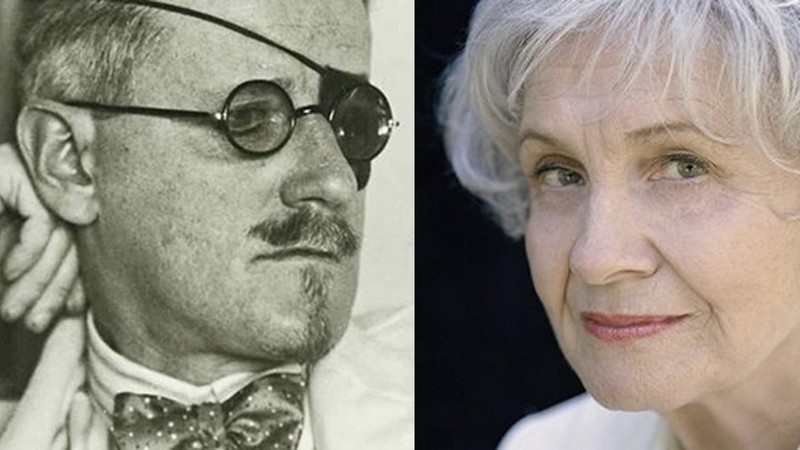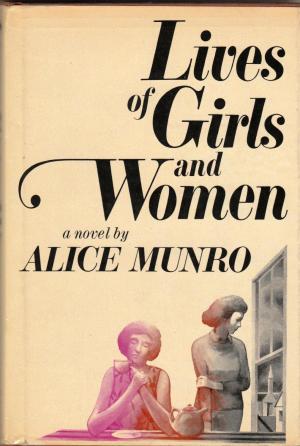.
In Alice Munro’s work Lives of Girls and Women—billed as a novel, though it is more of a collection of linked stories—“Baptizing” plays Del Jordan, a high school senior seeking sexual initiation, against three antagonists. Two of these encounters end in comic humiliation, while the third is a breathtakingly carnal adventure until she breaks up explosively with her boyfriend.
First, Del meets Clive through her friend Naomi at a trashy bar, but the encounter goes no further than making out drunkenly. Second, she halfheartedly dates her brilliant, socially awkward high school classmate Jerry Storey. And finally, she has a full love affair with a Baptist lumberyard worker named Garnet French. As Glover notes in his essay “The Style of Alice Munro” (from The Cambridge Companion to Alice Munro), “this strategy of varying plot structure by using different antagonists in each plot step is also used in James Joyce’s ‘The Dead,’ in which the protagonist Gabriel interacts dramatically with three successive women, Lily, the maid, Miss Ivors, the fellow journalist, and, finally, his wife” (48).
Let us start, then, by examining “The Dead.”
Glover expands on his analysis of the Joyce masterpiece in Attack of the Copula Spiders (27-29). In each encounter, Glover says, Gabriel oversteps by making assumptions about the women, who put him in his place. Each of the three set pieces end with Gabriel miffed, nonplussed, humiliated, and disabused of some modicum of his self-delusions. Gabriel jokes with Lily, the caretaker’s daughter that everyone would be going to her wedding to a fine young man one day. This is harmless banter of the sort Gabriel thinks should brighten the day of any working girl. But Lily has had it with her fine young man—with all men, really—and she holds Gabriel accountable for the failings of his wicked gender. “The men that is now is only all palaver and what they can get out of you,” she says. Gabriel colors in embarrassment.
Next he crosses swords with Miss Ivors, a patriot who gratuitously insults Gabriel’s honor as an Irishman because he has the temerity to write book reviews for a British paper. (The nerve!) “West Briton!” she calls him. She apologizes passive-aggressively but smilingly repeats her slander, leaving Gabriel embarrassed and angry. She possesses the passive-aggressive’s gift for detecting a tender spot in her interlocutor’s psyche—a place of insecurity, self-doubt, weakness, or shame—and jabbing him there with a well-filed fingernail. Gabriel pettily avenges himself with oblique allusions to a strawman version of Ivors in a toast over dinner—after she has left the party and can no longer respond. So there!
Finally, the shifting fault lines of the party unearth the coffin of a buried conflict with his wife, Greta. She suggests that they go to Galway for a visit. “You can go if you like,” he says coldly. In a later conversation in their bedroom, Gabriel, aflame with lust for Gretta, is astonished when she bursts into tears. Turns out she is crying over a boy named Michael Furey whom she was in love with, and who died in Galway years ago. Though frail in his health, he stood out in a cold rain pining for her, fell sicker yet, and died. “I think he died for me,” she says. Gabriel achieves an epiphany of sorts, a bitter one: he has never really known his wife, and now he sees her as someone whose soul he cannot fathom, who has loved another more deeply than she will ever love him. He cannot forgive himself for his petty preoccupations in the face of his wife’s deep, true grief. His newfound self-knowledge is rendered comical by his fantastical, exaggerated self-lacerations, of a sort familiar to psychologists. If he must fail, Gabriel must do so in a spectacular manner: “He saw himself as a ludicrous figure, acting as a pennyboy for his aunts, a nervous, well-meaning sentimentalist, orating to vulgarians and idealising his own clownish lusts…” Joyce leaves us with a Gabriel-in-a-hair-shirt who is the mirror image of his former vain self. A few sessions with a good shrink might help him sort out his self-image, even if there is little that can be done about clownish male lusts.
Glover states that in these encounters, “Each woman is more important to Gabriel than the previous one. Each comes closer to threatening and overturning his core psychic constructs. And each woman confronts him with the truth” (Attack, 29).
Similarly, in “Baptizing,” Munro arranges three stories that, individually, are broken up in a series of steps, Glover states, “so that they form a miniature story, a dramatic whole within the larger structure of the story.” Each chapter of this tale ends in Del walking home alone.
In the first set piece of “Baptizing,” Del is an inexperienced newcomer in the grotty Gay-la Dance Hall, which her mother, despite her irreligiousness, compares to the biblical Sodom and Gomorrah. The man Del is paired off with, Clive, amuses himself faking Dutch immigrant and black accents with his friend.
“Hey, Rastus,” Bert says “spookily” (210—gap-mouthed italics my own). Clive is a fancy, inventive dancer who leaves Del feeling awkward as she tries to match his moves. Back at the table, she “drinks like a fish,” as Naomi approvingly observes. But when the foursome leave and drive about in Clive’s friend’s car, Clive pounces on Del (so drunk she has forgotten she is sitting beside him) and slides his tongue down her throat “like an enormous, wet, cold, crumpled … dishrag” (208). They all end up in a hotel, but after heading down the hall to use the toilet, Del removes her shoes, climbs down the fire escape, and walks off barefooted. In her drunken confusion she first wobbles to Naomi’s home, waking Naomi’s father (who later gives his daughter a belting when she returns home). Del finally ends up in her own bed, alone and hungover, in a dry-mouthed conclusion to this failed romantic evening.
The second set piece likewise ends in failure and with Del fleeing into the night. But it veers even further into slapstick, “something jerky and insane from a silent movie,” she later reflects (226). The story involves the teenage genius Jerry Storey. Student body opinion has paired off Del off with the boy for the sole reason that they are the two top scholars. Almost against their will, they fall into a relationship. Jerry shows a not-atypical masculine preoccupation with himself and his achievements. A science and math prodigy, he is baffled by Del’s areas of giftedness, as in her love of literature. Fairly or not, one is tempted to merge the character Del with a young Munro, yet it is Jerry who daydreams about winning the Nobel Prize in, oh, let’s say ten years or so, maybe twenty (217). Like Clive, Jerry uses fake accents—those of British sophisticates or characters from the comic strip “Pogo,” though this time Del joins in with him in silly dialogues that cover their sense of awkwardness together. As with Clive, their sexual exploration is desultory and amusingly unsexy.
Our hands lay moistly together, each one of us wondering, no doubt, how long in decent courtesy they must remain. Our bodies fell together not unwillingly but joylessly, like sacks of wet sand. Our mouths opened into each other … our tongues rough, mere lumps of unlucky flesh (222).
(Again, those dreadful tongues down the throat.)
The relationship climaxes (in a literary if not physical sense) with Del undressing and lying on Jerry’s bed. Embarrassed, they resort to Pogo accents: “Yo’ is shore a handsome figger of a woman,” he tells her (223). But ludicrously, Jerry hears his mother returning home, and he shoves his naked girlfriend into the basement stairway, leaves her there in the dark. Later he tosses her clothes down the laundry chute. She climbs out a window, and again walks home at night in shame and fury. (They make up the next day.)
As authors must, Munro saves her climactic story—her most affecting and beautiful one—for the conclusion. Del has a love affair with lumberyard worker Garret French. She meets him at a revival meeting that she, a nonbeliever, whimsically decides to attend after a teacher who is a Presbyterian elder gives her a promotional button that reads Come to Jesus. There, Garnet spies Del from across the room and works his way over to her. They don’t even know each other’s name, yet he holds her hand as they listen to a hellfire sermon from an itinerant revivalist. It’s a gorgeous way to create dramatic tension—to have the seduction occur, irreverently and irresistibly, in a religious service. Here Munro nods to another work by Joyce, A Portrait of The Artist as a Young Man, which recounts a sermon delivered amid Stephen Daedalus’s preoccupation with fleshly depravities. In “Baptizing,” the preacher’s key image, that of the sinner crossing a rope bridge held by a thread over the chasm of Hell, also alludes to Jonathan Edwards’ “Sinners in the Hands of an Angry God,” but in a comic twist, Del and indeed the entire audience do not quake in their seats, like Edwards’ congregation, but are entertained by a threat of damnation from which they consider themselves personally exempt. As the preacher orates, people sing out, “Amen.” Del muses, “Movie stars and politicians and fornicators gone beyond rescue; it seemed, for most people, a balmy comfortable thought” (233). The affair that follows is all-consuming, even before it is consummated. Del lies awake sleepless until dawn, reviewing every kiss and touch. “Sex seemed to me all surrender—not the woman’s to the man but the person’s to the body, an act of pure faith, freedom in humility” (239—italics mine).
Glover discerns echoes among Munro’s three set pieces. Del and Garnet visit each other’s homes for a meal, just as Jerry and Del do. Garnet’s sprawling, working class family attracts Del in a way that Jerry and his widow mother do not, but there are similarly uncomfortable sexual revelations in each household. Jerry’s mother, ambitious for her boy’s future, warns Del to use birth control when having sex; Garnet carves the names of his conquests into a beam on the porch, Del’s last of all, underscored and surrounded by stars, indicating she would be his wife.
All three relationships implode, the first two comically, while her final, deepest one ends in tragic rage and a kind of betrayal (a betrayal, that is, by Del; she admits this to herself, even though she is a victim of Garnet’s physical brutality). Del and Garnet go swimming together after making love (258 ff). Garnet tells her she must get baptized as a member of his church. Although minutes earlier she has agreed to bear his children, she resists baptism, recognizing that to do so would be to surrender something essential about herself. His half-joking attempt to baptize her himself turns vicious as he realizes the love he has offered is not reciprocated—that “I had somehow met his good offerings with my deceitful offerings … matching my complexity and play-acting to his true intent” (260). He nearly drowns her, but she refuses to give in and manages to escape his clutches. For a third time, the end of a relationship leaves her walking home.
This final set piece provides a revelation to Del, an epiphany, which unites all three panels of the literary triptych. “The scene has the force of a spell being broken: Del speaks of sleepwalking, of waking up,” Margaret Atwood writes in The Cambridge Companion (111). In her encounters with Clive and Jerry, Del was denied not only sexual fulfillment, but the enlightenment of self-knowledge as to where she stands in relation to men. With Garnet, she finds a deeply satisfying sexual relationship—rare in this life, as she is aware—but with a man with whom she has no future. She must give it up to awaken herself from the spell.
—Russell Working
Works Cited
Alice Munro: Lives of Girls and Women
James Joyce: Dubliners
Douglas Glover: Attack of the Copula Spiders
Douglas Glover, Margaret Atwood et al.: The Cambridge Companion to Alice Munro
.
Russell Working is the Pushcart Prize-winning author of two collections of short fiction: Resurrectionists, which won the Iowa Short Fiction Award, and The Irish Martyr, winner of the University of Notre Dame’s Sullivan Award. His stories and humor have appeared in publications including The Atlantic Monthly,The Paris Review, TriQuarterly Review, Narrative, and Zoetrope: All-Story. A writer living in Oak Park, Ill., he spent five years as a reporter at the ChicagoTribune. His byline has appeared in the New York Times, BusinessWeek, theBoston Globe, the Los Angeles Times, the South China Morning Post,the Japan Times, and dozens of other newspapers and magazines around the world.
.
.



